After Body Press
After Body Press is a multi screen video work that runs in a maze-like configuration through the ground floor galleries of Robert Adams’ Eighteenth Century house, Osterley Park. Filmed in the renowned and incredibly grand Neo-Classical rooms of Osterley Park itself, After Body Press creates an endlessly moving environment of synchronised swirling, doubled images that fold into each other along six specially arranged projection screens.
These multiple, episodic and wandering images were captured by Ellard and Johnstone using two hand-held cameras that were passed between the artists in a baton-like fashion according to a range of pre-planned and tightly choreographed movements. Sometimes these movements are tied to the contours and reach of the body as it perambulates through the building, while on other occasions the camera movements mimic the roving of the eye as it traces the lines of Robert Adams’ remarkable decorative pattern work in carpets, ceilings and wall friezes.
Like the other recent video installations created by Graham Ellard and Stephen Johnstone, such as Geneva Express (Photographers’ Gallery, 1998) and Wall of Death (Cornerhouse, Manchester, 1999), this latest piece draws on and emphasises the architectural qualities of the projected video image to create an immersive and dynamic space that the spectator experiences as a kind of performer. Integral to these installations is the recognition that the viewer must act or perform simple, sometimes unconscious or involuntary acts in the space in order to experience the work; swivelling through 180 degrees in Geneva Express to ‘watch’ a plane pass overhead, spinning back and forth to unravel the logic of a doubled, unending car chase circling the viewer in Wall of Death.
The origins of the After Body Press are to be found in some photographs of a now little seen performance film by the American artist Dan Graham titled Body Press (1970-72). In an account his double projection film Graham describes how, by using two cameras passed between two performers in a spiralling figure of eight movement, he attempted to demonstrate the relationship between human eye, human body, camera eye and camera body. For Ellard and Johnstone the diagrammatic photographs of the filming process Graham employed in Body Press suggested a way of recording a performance of Adams’ house in which the video camera literally takes on the optical vantage of the roving body.
This relationship between camera and body is then mirrored in the resulting installation of synchronised, multiple projections as the viewer is invited to similarly engage with the mechanics and performance of looking.
(Catalogue statement).
top
work
home
|
|
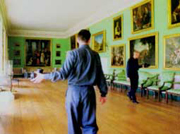
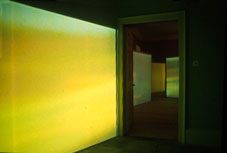
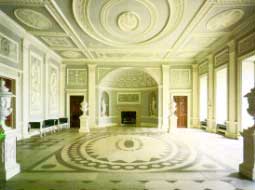
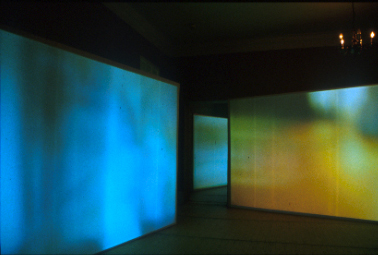
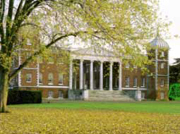
From top:
Shooting After Body Press
Installation view
Interior; Osterley Park House.
Installation view
Exterior; Osterley Park House.
|